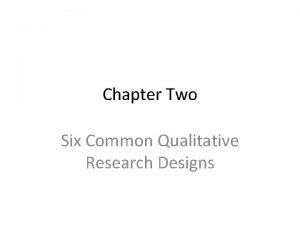Chapter Two Six Common Qualitative Research Designs Introduction










- Slides: 10

Chapter Two Six Common Qualitative Research Designs

Introduction • There are numerous approaches to qualitative research. • This course focuses on six common types: basic qualitative research, phenomenology, grounded theory, ethnography, narrative analysis, and qualitative case study. • Differences manifest in how the research question might be asked, sample selection, data collection and analysis, and write-up. • There can also be overlaps in these types of research, such as in an ethnographic case study.

Basic Qualitative Researchers conducting a basic qualitative study are interested in (1) how people interpret their experiences, (2) how they construct their worlds, and (3) what meaning they attribute to their experiences. The other types of qualitative studies examined in Chapter 2 have these characteristics plus an additional dimension.

Basic Qualitative Research, cont’d • Data collection is through interviews, observations, or document analysis. What questions are asked, what is observed, and what documents are deemed relevant will depend on the disciplinary theoretical framework of the study. • Data analysis involves identifying recurring patterns that characterize the data. • Findings are these recurring patterns or themes supported by the data from which they were derived. • The overall interpretation will be the researcher’s understanding of the participants’ understanding of the phenomenon of interest.

Phenomenology • In a phenomenological approach the researcher isolates a phenomenon in order to depict the essence or basic structure of experience. • This approach is well suited to studying affective, emotional, and often intense human experiences. • Phenomenological interview: Data collection method whereby different people’s experiences are bracketed, analyzed, and compared to identify the essence of a phenomenon. • Epoche (Suspension of judgment)/ Bracketing: Before interviewing participants, the researcher explores his or her own experiences, recognizing and setting aside biases and assumptions.

Phenomenology, cont’d. • Phenomenological reduction: Continually returning to the essence of the experience to derive the inner structure or meaning in and of itself. • Horizontalization: Treating all data as having equal weight at the initial data analysis stage, before organizing the data into clusters or themes. • Imaginative variation: Viewing the data from various perspectives. • The product of a phenomenological study is a composite description of the essential, invariant structure (or essence) of a commonly experienced phenomenon.

Ethnography • Ethnography focuses on the beliefs, values, and attitudes that structure the behavior patterns of a specific group of people. • Data collection is primarily by immersion in the site as a participant observer. • Interviews and analysis of documents, records, and along with a fieldworker’s diary, comprise the data set. • The end product of research is characterized by thick description as well as interpretation. • Extensive data gathering is necessary to produce a cultural interpretation of the phenomenon. • Organization of data depends on discipline. Anthropologists often use preexisting category schemes (etic/outsider perspective). Researchers in other fields are likely to organize their findings into schemes derived from the data themselves (emic/insider perspective).

Grounded Theory • The result of this type of qualitative study is a theory that emerges from, or is “grounded” in, the data. Grounded theory is particularly useful for addressing questions about how something changes over time. • The researcher concurrently collects, codes, and analyzes data using the constant comparative method of data analysis. • Conceptual elements of a grounded theory: – The core category – Other categories, and the properties that define or illuminate them – Hypotheses that emerge from the data.

Narrative Inquiry • Date consists of first-person accounts of experience, such as autobiographies, life histories, or journals. • The researcher essentially becomes a coauthor, either directly, such as by interviewing the author to elicit an account, or indirectly, by representing and thus transforming others’ texts and discourses. • Hermeneutics: To make sense of and interpret a text, it is important to know what the author wanted to communicate, to understand intended meanings, and to place documents in a historical and cultural context. • Methodologies: Biographical, psychological, and linguistic approaches are the most common.

Qualitative Case Studies • A case study differs from the other types of qualitative research because it is defined by the unit of analysis (the case) rather than the topic of study. • Case: A case could be a single person who is an example of some phenomenon, a program, a group, an institution, a community, or a specific policy. • Bounded system: To be a case, a phenomenon must be intrinsically bounded. One technique for assessing boundedness is to ask how finite the data collection would be. • Comparative case studies: These involve collecting and analyzing data from several cases. The more cases included in a study, and the greater the variation across the cases, the more compelling your interpretation is likely to be.
 Chapter 10 qualitative research designs
Chapter 10 qualitative research designs Chapter 10 qualitative research designs author
Chapter 10 qualitative research designs author Features of qualitative research
Features of qualitative research Types of qualitative research designs
Types of qualitative research designs Qualitative proposal example
Qualitative proposal example Chapter 3 research respondents
Chapter 3 research respondents Research design
Research design Qualitative research
Qualitative research Common organizational designs
Common organizational designs Sample learning areas that can be used in research.
Sample learning areas that can be used in research. Ethical issues in qualitative research chapter 4
Ethical issues in qualitative research chapter 4



















